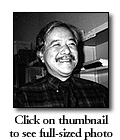Gary Tom
Dean, Alemany Campus
Director, Affirmative Action Office
Associate Director, Office of the Vice President
Assistant Director, Allied Health Training Programs
Assistant Director, Chinatown/ North Beach Campus
Assistant Director, John O'Connell Campus
Coordinator, Veterans Educational Incentive Program
Office of the Mayor, San Francisco,
Principal Planner and Chief Monitor, Office of Employment and Training, 1975 - 1977
Coro Foundation, Fellow 1974
United States Civil Rights Office, Washington, D.C., Program Policy Specialist 1973
Excerpt from an interview with:
GARY TOM by CUBA Z.MILLER
February 29, and March 15, 1996
San Francisco, California
MILLER:
Gary, what's the relationship between basic ed. and job training?
TOM:
When you say "basic ed.," you're talking about native-born English speakers?
MILLER:
Either one.Either ABE or ESL
TOM:
Yeah.Well, as I mentioned before, there are bridges like vocational ESL, but I
think that we still need to concentrate on working with the training programs.
There's a dichotomy here because, for instance, if you want to train someone to
be a clerk-typist, to be marketable that person has to type 45 words a minute,
correctly.And to ask an English as a second language person or a native-born
ABE person with limited skills to do that, it takes extensive training. It's
not an overnight situation. I think that problems with the federal and state
funding is that they need to do something quick, and the quick fix does not
work in the long run, because even if they got into the job, they may not be
able to hold the job.
MILLER:
If they don't have a strong enough basic education.
TOM:
Right, so we go back to basic education, which in reality takes a long time.If
someone is non-literate, it will take them five to eight years to reach a point
where they would have marketable … truly marketable skills.And we may turn
out people with high school diplomas, but they still are not ready for jobs.
So, to answer your question somewhat, there's a big gap between ABE and job
training, that we're still struggling with even today.
MILLER:
Actually, I'm jumping forward a little bit, but in the re-authorization of the
federal funds at this point, they're looking more and more towards job training
with only limited amounts set aside for these pre-employment skills.
TOM:
Yeah.To me, and this is my personal, individual perspective, training funds
come in cycles, four-year cycles, depending on who gets elected.And that
person has to show results within the four years or he or she doesn't get
reelected.So we're caught in this problem where, even if you found the money
and allocate the money, it takes a year to develop the processes and programs
to get it off the ground. It takes another year to get it to the
community-based agencies or the public institutions.It takes another year of
trial-and-error to find your way around, because nothing's perfect. By the [end
of the] third year you're kind of on your way. Then the fourth year comes the
reelection and we go through the same thing again if the individual is not
reelected or if the party is not reelected.And so we're caught in this
short-term answers for long-term problems.

